BW Statistics
BW Statistics is a multi-cube named 0BWTC_C10. It contains six basic cubes, each of which stores specific system performance information (Screen 13.1).
SCREEN 13.1
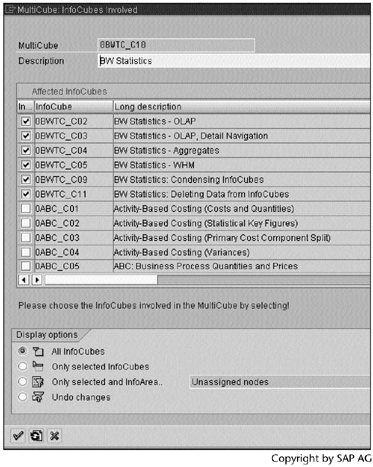
BW Statistics works as follows:
- The raw statistical data are collected in database tables, such as RSDDSTAT, RSDDSTATWHM, and RSDDSTATAGGR.
- The raw statistical data are loaded into the basic cubes through the regular BW data load procedure.
- We run queries on the multi-cube to obtain BW performance information.
To specify the InfoCubes for which we want to collect statistical data, follow these steps:
Work Instructions
Step 1. In Administrator Workbench, select BW statistics for InfoCubes from the Tools menu.
SCREEN 13.2
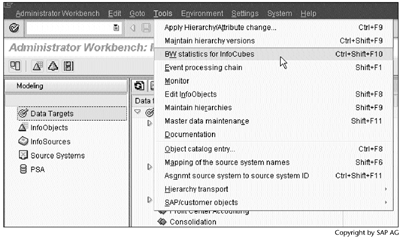
Step 2. Select the InfoCubes for which we need to collect statistic data, and then click  .
.
SCREEN 13.3
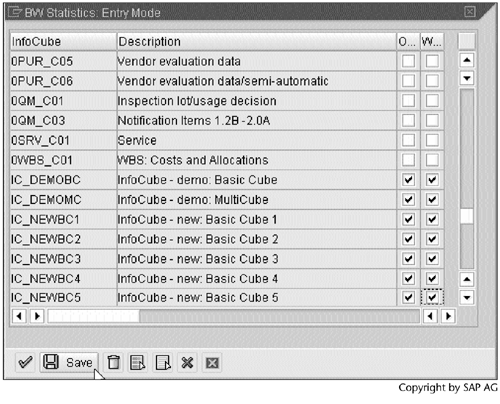
Note
Check column OLAP to collect OLAP-related statistical data, such as the number of records retrieved from the database. Check column WHM (WareHouse Management) to collect ETTL and data management-related statistical data, such as the number of records loaded into an InfoCube.
Step 3. To delete statistical data from the database tables, such as RSDDSTAT, click  in Screen 13.3. In the pop-up window, specify a date and time period, and click
in Screen 13.3. In the pop-up window, specify a date and time period, and click  . The statistical data in the specified date and time period will then be deleted.
. The statistical data in the specified date and time period will then be deleted.
SCREEN 13.4
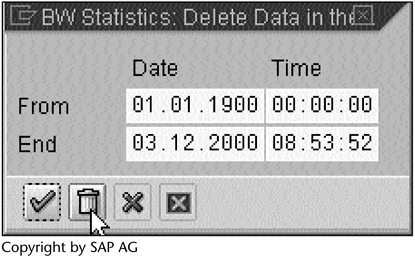
To give you an idea of the performance information that BW Statistics can provide, Table 13.1 lists SAP-delivered queries for the multi-cube 0BWTC_C10.
| Query | Characteristics | Key Figures |
|---|---|---|
| Chart: Records OLAP per InfoCube |
BW system InfoCube |
Overall time (OLAP) Records, selected on database Records, transferred from the database Cells, transferred to front end Formatting, transferred to front end Number, read texts |
| Chart: Times OLAP per InfoCube |
BW system InfoCube |
Time, initializing the OLAP processor Time, OLAP processor Time, read on the database Time, front end Time, authorization check Time, read texts/master data |
| Mean time per query |
BW system User InfoCube Aggregate Query (UID) |
Number of navigations Overall time (OLAP) Mean overall time (OLAP) Mean time, initializing OLAP Mean time, OLAP processor Mean time, reading database Mean time, front end Mean time, authorization check Mean time, reading texts/master data Mean number of records, selected on the database Mean number of records, transferred from the database Mean number of cells, transferred to front end Mean number of formatting, transferred to front end Mean number of texts, read |
| OLAP performance with/without reading on demand/aggregates |
BW system User InfoCube Query OLAP read on/off Aggregate |
Number of navigations Overall time (OLAP) Mean overall time (OLAP) Mean time, initializing OLAP Mean time, OLAP processor Mean time, reading database Mean time, front end Mean time, authorization check Mean time, reading texts/master data Mean number of records, selected on the database Mean number of records, transferred from the database Mean number of cells, transferred to front end Mean number of formatting, transferred to front end Mean number of texts, read |
| Rolling up aggregates |
BW system InfoCube User Superior cube Aggregate cube Aggregate |
Number of navigations Last used (day) Last used (time of day) |
| Run-time query |
BW system User InfoCube Query Validity period category |
Number of navigations Mean overall time (OLAP) Overall time (OLAP) Time, initializing the OLAP processor Time, OLAP processor Time, read on the database Time, front end Time, authorization check Time, read texts/master data Overall number (OLAP) Records, selected on database Records, transferred from the database Cells, transferred to front end Formatting, transferred to front end Number, read texts |
| Transfer method loading data |
BW system Automatically/manually posted Calendar day Source system Transfer type (WHM) Times and records (WHM) InfoSource InfoPackage ID Transfer type WHM Data request (SID) |
Transfer type (WHM) Time (procedure WHM) Records (procedure WHM) |
| Use of InfoObjects |
BW system Characteristic value Hierarchy Aggregation level InfoObject type InfoObject |
Number of navigations Last used (day) Last used (time of day) |
| Use of InfoObjects in navigation |
BW system Statistical data UID Navigation step Front-end session Characteristic value Hierarchy level Hierarchy Aggregation level Aggregate OLAP read on/off InfoCube User Query InfoObject |
Frequency |
| Using aggregates (OLAP) |
BW system InfoCube Aggregate |
Number of navigations Last used (day) Last used (time of day) |
| Using hierarchies |
BW system InfoObject Characteristic value Aggregation level InfoObject type Hierarchy |
Number of navigations Last used (day) Last used (time of day) |
| Using InfoCube OLAP/WHM |
BW system InfoCube |
Time (OLAP/WHM) Total load time (WHM) Overall time (OLAP) Records (OLAP/WHM) Overall number (OLAP) Total number of records (WHM) |
| Using InfoCubes |
BW system InfoCube |
Number of navigations Last used (day) Last used (time of day) |
| Utilizing OLAP |
BW system User Time Calendar day Validity period category OLAP read on/off Navigation step Database read mode Aggregate UTC time stamp InfoCube Query |
Number of navigations Mean overall time (OLAP) Overall time (OLAP) Time, initializing OLAP processor Time, OLAP processor Time, read on the database Time, front end Time, authorization check Time, read texts/master data Overall number (OLAP) Records, selected on database Records, transferred from the database Cells, transferred to front end Formatting, transferred to front end Number, read texts |
| Utilizing OLAP according to date | Calendar day |
Overall time (OLAP) Overall number (OLAP) |
| Utilizing OLAP according to time of day | Time |
Overall time (OLAP) Overall number (OLAP) |
| Utilizing OLAP per InfoCube |
BW system InfoCube |
Number of navigations Mean overall time (OLAP) Overall time (OLAP) Time, initializing OLAP processor Time, OLAP processor Time, read on the database Time, front end Time, authorization check Time, read texts/master data Overall number (OLAP) Records, selected on database Records, transferred from the database Cells, transferred to front end Formatting, transferred to front end Number, read texts |
| Utilizing OLAP per query |
BW system Query |
Number of navigations Mean overall time (OLAP) Overall time (OLAP) Time, initializing OLAP processor Time, OLAP processor Time, read on the database Time, front end Time, authorization check Time, read texts/master data Overall number (OLAP) Records, selected on database Records, transferred from the database Cells, transferred to front end Formatting, transferred to front end Number, read texts |
| Utilizing OLAP per user |
BW system User |
Number of navigations Mean overall time (OLAP) Overall time (OLAP) Time, initializing OLAP processor Time, OLAP processor Time, read on the database Time, front end Time, authorization check Time, read texts/master data Overall number (OLAP) Records, selected on database Records, transferred from the database Cells, transferred to front end Formatting, transferred to front end Number, read texts |
| Utilizing WHM per InfoCube |
BW system InfoCube |
Time (procedure WHM) Records (procedure WHM) |
| Utilizing WHM per InfoSource |
BW system InfoSource |
Time (procedure WHM) Records (procedure WHM) |
| WHM usage per day | Calendar day |
Time (procedure WHM) Records (procedure WHM) |
| WHM usage per hour | Time |
Time (procedure WHM) Records (procedure WHM) |
Screen 13.5 shows an example of the query Mean Time per Query.
SCREEN 13.5
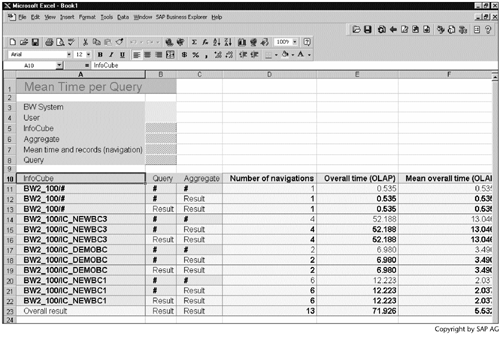
Note
When Screen 13.5 was produced, BW Statistics still needed some work. For example, the query did not give query and aggregate information. Later patches fixed most of the bugs.
The following procedure shows how to install BW Statistics and load statistics data into the basic cubes.
Work Instructions
Step 1. Repeat the procedure in Section 10.4, "Installing Business Content Objects and Loading R/3 Data," to activate the multi-cube 0BWTC_C10 and its six basic cubes from Business Content.
SCREEN 13.6
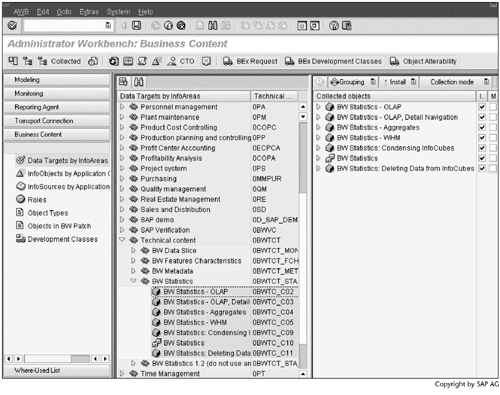
Step 2. To load data, we must transfer and replicate DataSources.
On the same BW system, run transaction RSA5, enter TCT in the Application Component field, and then click  to continue.
to continue.
SCREEN 13.7
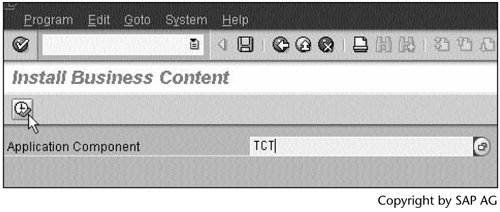
Note
TCT (Technical ConTent) is the application component that contains all DataSources related to BW Statistics and BW meta-data.
Step 3. Select all DataSources, and then click  .
.
SCREEN 13.8
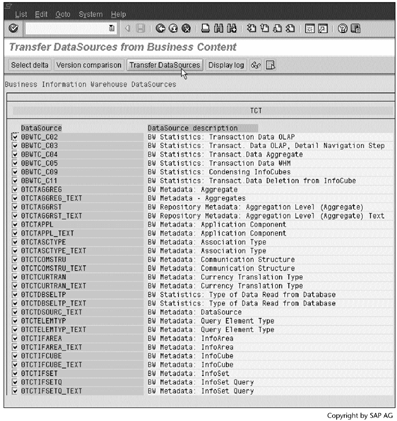
Step 4. The DataSources must be included in a development class to be transported to other BW systems. Here we create them as local objects.
Enter $TMP as the development class name and click  , or simply click
, or simply click  to assign the object to $TMP. Click
to assign the object to $TMP. Click  to continue.
to continue.
SCREEN 13.9
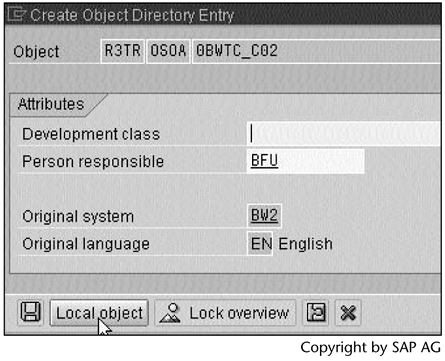
Step 5. Next, we need to replicate the DataSources.
In Administrator Workbench, right-click the BW system, and then select Replicate DataSources.
Note
The BW system is its own source system here.
SCREEN 13.10
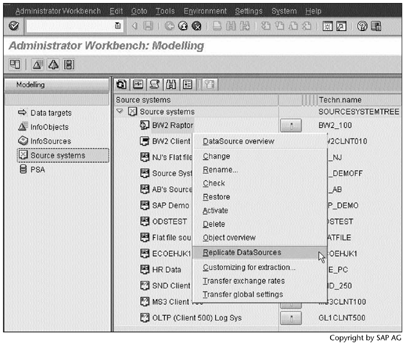
Next, we load the statistical data into the basic cubes. The following steps provide an example of loading data into a basic cube, 0BWTC_C02.
Step 6. Right-click the InfoSource 0BWTC_C02, and then select Assign DataSource….
SCREEN 13.11

Step 7. Enter the BW system itself as the source system. Click  to continue.
to continue.
SCREEN 13.12
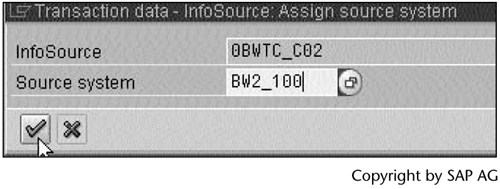
Step 8. Select the corresponding DataSource. Click  to continue.
to continue.
SCREEN 13.13
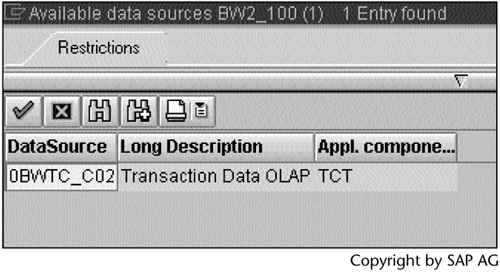
Step 9. Click  to continue.
to continue.
SCREEN 13.14

Step 10. Click  to activate the transfer rules, and then go back to Screen 13.16.
to activate the transfer rules, and then go back to Screen 13.16.
SCREEN 13.15
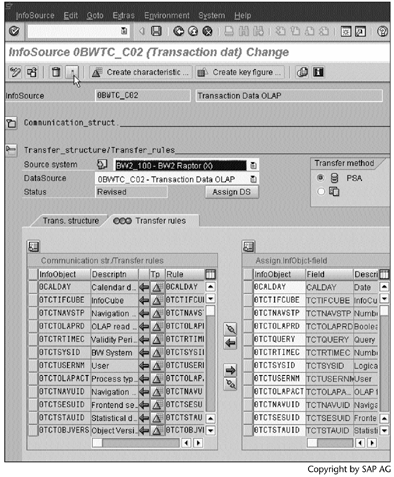
Step 11. Right-click the source system, and then select Create InfoPackage….
SCREEN 13.16
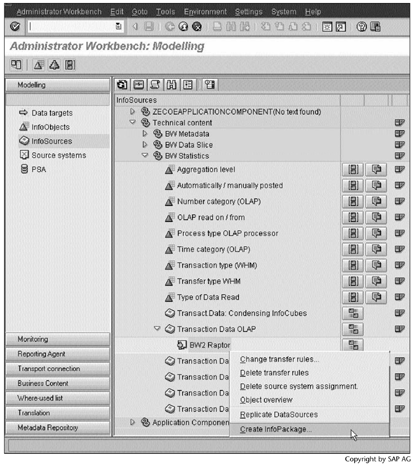
Step 12. Select the DataSource, enter a description, and then click  to continue.
to continue.
SCREEN 13.17
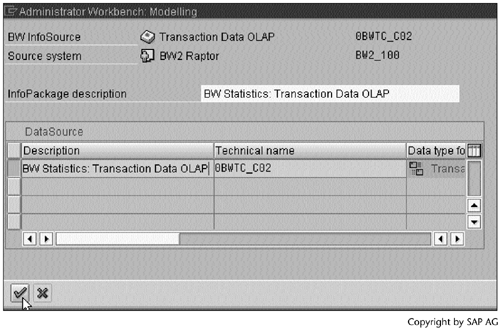
Step 13. Click  to start the data load.
to start the data load.
SCREEN 13.18
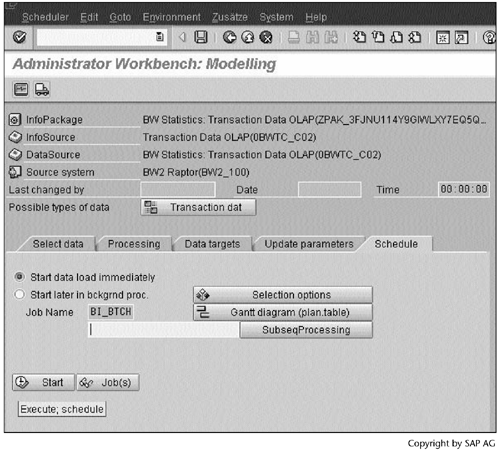
Result
BW Statistics has been activated and loaded with statistical data. You can now run any query against the multi-cube to obtain system performance information.
Besides BW Statistics, several other tools can help us monitor general system performance. We will discuss one of them next.
Part I. Guided Tours
Business Scenario and SAP BW
- Business Scenario and SAP BW
- Sales Analysis A Business Scenario
- Basic Concept of Data Warehousing
- BW An SAP Data Warehousing Solution
- Summary
Creating an InfoCube
- Creating an InfoCube
- Creating an InfoArea
- Creating InfoObject Catalogs
- Creating InfoObjects Characteristics
- Creating InfoObjects Key Figures
- Creating an InfoCube
- Summary
Loading Data into the InfoCube
- Loading Data into the InfoCube
- Creating a Source System
- Creating an Application Component
- Creating an InfoSource for Characteristic Data
- Creating InfoPackages to Load Characteristic Data
- Checking Loaded Characteristic Data
- Entering the Master Data, Text, and Hierarchy Manually
- Creating an InfoSource for Transaction Data
- Creating Update Rules for the InfoCube
- Create an InfoPackage to Load Transaction Data
- Summary
Checking Data Quality
- Checking Data Quality
- Checking InfoCube Contents
- Using BW Monitor
- Using the Persistent Staging Area (PSA)
- Summary
Creating Queries and Workbooks
- Creating Queries and Workbooks
- Creating a Query Using BEx Analyzer
- Organizing Workbooks Using BEx Browser
- Using a Variable to Access a Hierarchy Node Directly
- Summary
Managing User Authorization
- Managing User Authorization
- Creating an Authorization Profile Using Profile Generator
- Creating an Authorization Object to Control User Access to the InfoCube Data
- Integrating Profile Generator and BEx Browser
- Summary
Part II. Advanced Topics
InfoCube Design
- InfoCube Design
- BW Star Schema
- InfoCube Design Alternative I Time-Dependent Navigational Attributes
- InfoCube Design Alternative II-Dimension Characteristics
- InfoCube Design Alternative III Time-Dependent Entire Hierarchies
- Other InfoCube Design Techniques
- Summary
Aggregates and Multi-Cubes
Operational Data Store (ODS)
- Operational Data Store (ODS)
- Creating an ODS Object
- Preparing to Load Data into the ODS Object, Then into an InfoCube
- Loading Data into the ODS Object
- Loading Data into the InfoCube
- Using 0RECORDMODE for Delta Load
- Summary
Business Content
- Business Content
- Creating an R/3 Source System
- Transferring R/3 Global Settings
- Replicating R/3 DataSources
- Installing Business Content Objects and Loading R/3 Data
- Summary
Generic R/3 Data Extraction
- Generic R/3 Data Extraction
- Creating Views in R/3
- Creating DataSources in R/3 and Replicating Them to BW
- Creating a Characteristic in BW
- Loading Data from R/3 into BW
- Summary
Data Maintenance
Performance Tuning
- Performance Tuning
- BW Statistics
- System Administration Assistant
- Tuning Query Performance
- Tuning Load Performance
- Summary
Object Transport
Appendix A. BW Implementation Methodology
Object Transport
Appendix B. SAP Basis Overview
Object Transport
- Object Transport
- Section B.1. SAP Basis 3-Tier Architecture
- Section B.2. Dispatcher, Work Processes, and Services
- Section B.3. Memory Management
Appendix C. Glossary
Appendix D. Bibliography
EAN: N/A
Pages: 106
- Chapter IV How Consumers Think About Interactive Aspects of Web Advertising
- Chapter VII Objective and Perceived Complexity and Their Impacts on Internet Communication
- Chapter IX Extrinsic Plus Intrinsic Human Factors Influencing the Web Usage
- Chapter X Converting Browsers to Buyers: Key Considerations in Designing Business-to-Consumer Web Sites
- Chapter XII Web Design and E-Commerce
